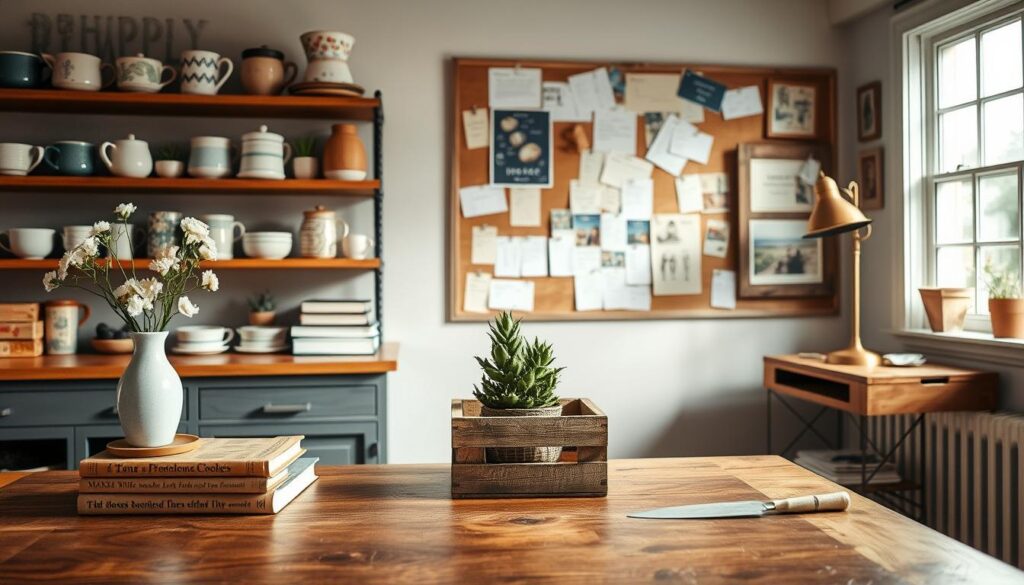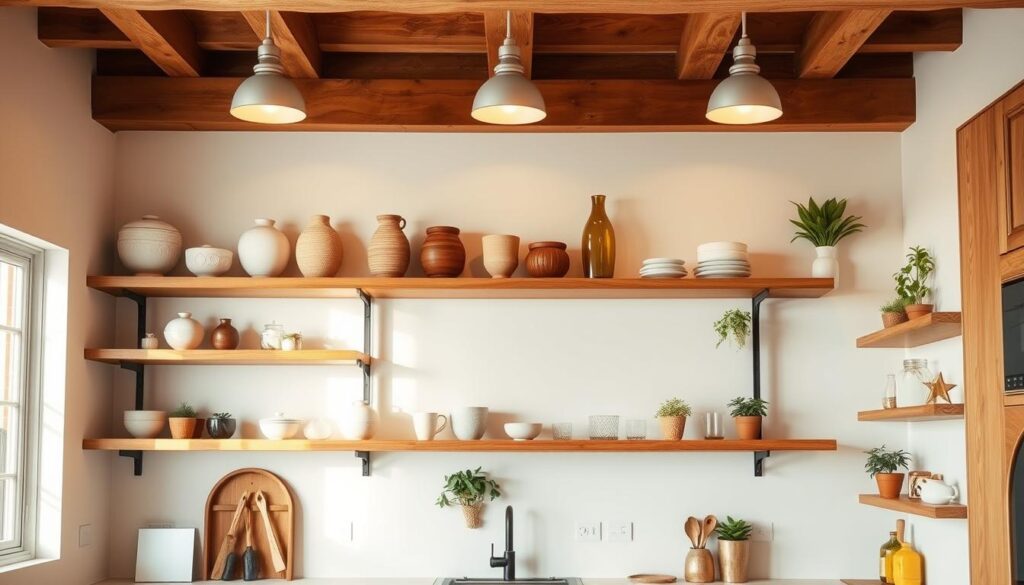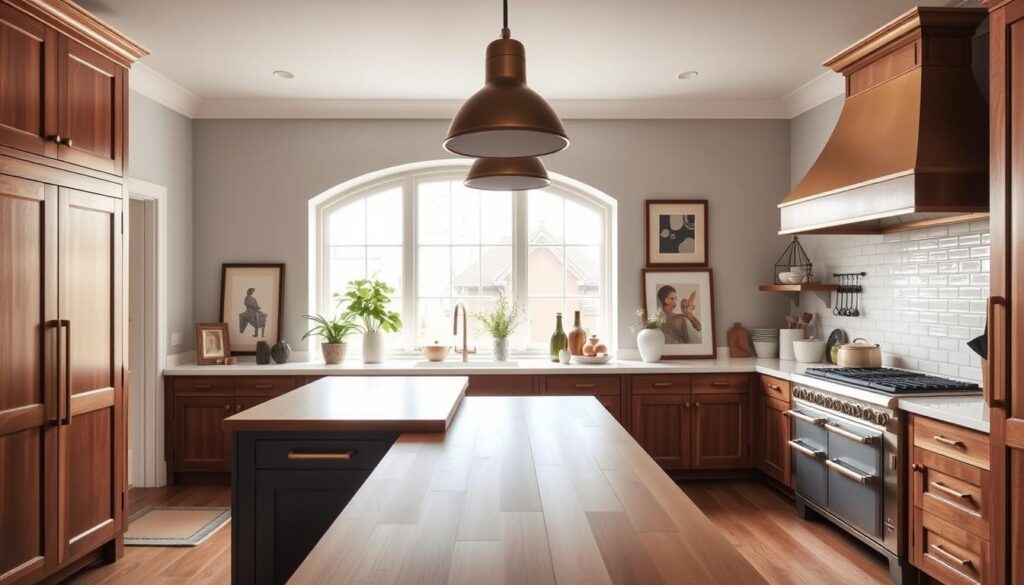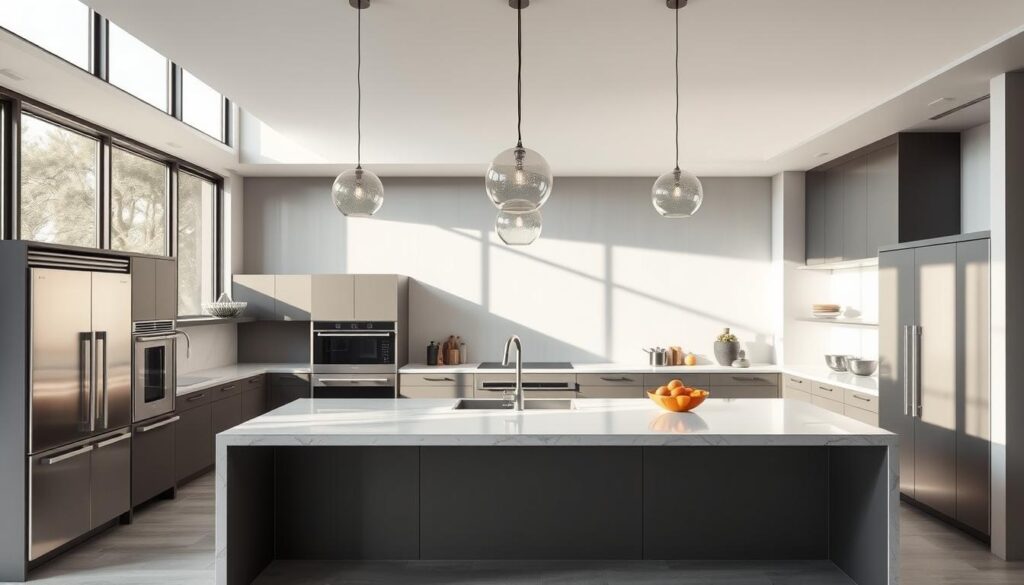I’ll never forget walking into my friend’s cooking space last summer. She’d transformed ordinary shelves into a vibrant gallery of memories – hand-painted ceramics from Mexico, weathered recipe cards in vintage frames, and a retro mixer that’d belonged to her great-aunt. That’s when I realized: our most-used rooms deserve to tell our stories too.
Designers like Crina Arghirescu Rogard prove you don’t need a full renovation to create magic. Her Brooklyn home showcases treasures from global adventures alongside modern essentials. Those Portuguese glass jars? They hold spices now. Antique plates? They’re art when displayed thoughtfully.
Maybe you’ve got a cherished charcoal sketch tucked away or Grandma’s mixing bowl collecting dust. These aren’t just objects – they’re design opportunities. Sam Sacks nailed this in a Toronto project, pairing heirloom appliances with sleek new cabinetry. The result? A space that feels both timeless and fresh.
We’ll explore how to blend old and new, share budget hacks that deliver big impact, and reveal why your cooking area should get the same love as your living room. Ready to create a space that’s truly yours? Let’s begin.
Budget-Friendly Kitchen Decor Solutions
Those emerald-green Schumacher curtains stopped me mid-sip at Paperdoll bar last year – little did I know they’d later become designer Danielle Balanis’ secret weapon in a kitchen makeover. That’s the magic of smart styling: ordinary items become extraordinary when we see their hidden potential.

Affordable Style Tips
Start with what you’ve got. That chipped dresser? Prime it white for rustic charm. Those mismatched plates? Create a wall display. My go-to tricks:
- Swap cabinet pulls for $3 vintage finds
- Use thrifted trays as artful organizers
- Apply peel-and-stick tiles behind open shelves
Smart Upcycling Ideas
Balanis proved fabric scraps can transform windows, but let’s push further. Turn:
- Old ladders into pot racks
- Silverware dividers into spice organizers
- Framed cookbook pages into focal walls
I recently helped a client repurpose her grandmother’s bread cabinet as a coffee station – complete with chalkboard doors. As woodworking experts will tell you, sometimes the best solutions are already in your space.
Integrating Open Shelving and Smart Storage Options
What if your storage solutions became the star of the room? I discovered this magic while touring a California barn conversion where designer Adam Ben Wagner reimagined cabinetry as floor-to-ceiling bookshelves. Suddenly, functional storage felt like stepping into a cozy library – and I knew this approach could work anywhere.

Untraditional Shelving Concepts
Forget basic floating boards. Wagner’s design taught me to think vertically. Try:
- Repurposing ladder shelves against blank walls
- Installing staggered ledges above windows
- Using iron pipes as industrial-style brackets
In Los Angeles, Studio Mellone proved shelves can multitask. Their built-in units store cookbooks and display heirloom dishes – creating that irresistible “bookshelf wealth” vibe.
Designing with Open Bookshelves
The secret? Treat each shelf like a mini gallery. Alternate practical items (mixing bowls) with personality pieces (vintage scales). Group similar colors together, and leave breathing room between objects.
Create dedicated zones: everyday mugs at eye level, special china up high. Add trailing plants for softness, and stack weathered cookbooks horizontally. Suddenly, your storage tells a story – no renovation required.
Mixing Old with New for Timeless Appeal
Sam Sacks’ Toronto project still gives me chills – that cobalt-blue cabinetry framing a gleaming Officine Gullo sink like a modern jewel box. But what makes it sing? The client’s grandmother’s charcoal sketch hanging nearby, its smoky lines whispering family history. That’s the alchemy of blending eras.

Amber Lewis works similar magic. She transformed a client’s neon-yellow nightmare into a coastal sanctuary using patinaed copper and linen textures. The secret? Let materials age gracefully. “Marble develops character stains,” she told me, “while vintage metals tell their own stories.”
Want that soulful balance? Start with one heirloom piece – maybe your aunt’s vintage kitchen accents or childhood pottery. Build around it with clean-lined furniture. I recently paired a 1940s Mixmaster with matte-black shelves – the contrast made both elements shine brighter.
Three rules I live by:
- Repeat colors across old/new items (grandma’s amber glass ➔ modern brass handles)
- Let textures bridge time periods (weathered wood + smooth concrete)
- Leave breathing room – cluster vintage finds, then let sleek surfaces balance them
As woodworking pros know, the best designs feel collected, not decorated. Your space becomes a living scrapbook – where every chip and scratch adds depth to your story.
Kitchen Decor Ideas: Expert Tips for a Modern Cooking Space
What if your kitchen could host more cocktails than casseroles? Designer Breegan Jane asked herself this question while planning her space. “I’m not a cook,” she admits freely. Instead, she created an entertainment hub with a marble-topped island perfect for charcuterie boards and champagne toasts.

Caitlin Jones Ghajar took this philosophy further in a San Francisco apartment. Knowing her client preferred afternoon tea over elaborate meals, she designed compact zones for kettle access and cocktail prep. Your space should serve you – not some imaginary version of a TV chef.
Three rules I’ve learned from these innovators:
- Map your daily rituals first (coffee station > pasta maker)
- Use vertical storage for frequently grabbed items
- Hide appliances you rarely use behind cabinet doors
Ghajar proves less storage can mean better function. Her client’s narrow pull-out drawers hold exactly what’s needed: tea bags, crystal glasses, and artisanal bitters. No dead space. No clutter.
“Tech belongs in modern designs when it disappears,” Jane insists. She hides charging stations in drawers and uses voice-activated lighting. The result? A stylish area that adapts to real life – not the other way around.
Start with one honest question: What happens here daily? Your answer will shape the most useful (and beautiful) space you’ve ever created.
Adding Pop of Color and Statement Accents
A splash of tangerine in an otherwise neutral room can work wonders – just ask designer Maria Sanchez. I’ve seen bold choices transform sterile spaces into vibrant hubs, like Charlap Hyman & Herrero’s Miami project. Their secret? Pairing Boffi cabinets with Jean J. Datondant’s vivid artwork, creating a dialogue between sleek surfaces and hand-painted energy.
Choosing Bold Accent Pieces
Lindsay Speace taught me color balance matters most. When faced with a dominant 1960s brick wall in Durham, she added oversized lime-green apple art and custom Tolix stools in matching hues. The result? A cohesive look where no element overpowered another.
Try these strategies:
- Pick one hero color from existing elements (countertops, flooring)
- Repeat it in unexpected places – drawer pulls, appliance panels
- Use metallic finishes as neutral bridges between bold shades
Infusing Expressive Art Elements
Art shouldn’t hide in living rooms. I recently framed a client’s abstract watercolors as backsplash protectors – functional and eye-catching. Remember:
- Scale matters: Oversized pieces anchor busy walls
- Mix mediums – ceramic plates beside oil paintings add depth
- Let lighting enhance textures (spotlights for brushstrokes, diffused for ceramics)
Your palette tells your story. Whether through a single chartreuse stool or a gallery wall of thrifted plates, color becomes your silent co-host in every gathering.
Maximizing Small Kitchen Spaces Creatively
The tightest cooking areas often spark the most brilliant transformations. I saw this firsthand in Provincetown, where David Cafiero turned a cramped nook into a jewel box with floating shelves and a hand-painted tile backsplash. His secret? Treating every inch as prime real estate for beauty and function.
Michelle Gage’s Philadelphia studio proves bold choices shine in compact layouts. Her scalloped quartz feature wall creates upward movement without bulky cabinets. “Small spaces let you take design risks that pay off big,” she told me. This philosophy works wonders in Los Angeles apartments too, where vertical storage and reflective surfaces expand visual breathing room.
Try these tricks I’ve collected from designers:
Use open shelving to display colorful ceramics or cookbooks. Swap heavy curtains for breezy Roman shades. Mount under-cabinet lighting to brighten prep zones. For more smart small kitchen ideas, focus on multi-tasking elements – a fold-down table becomes a breakfast spot, while magnetic knife strips free up drawer space.
Remember: Limited square footage means every detail matters. That vintage rug? It warms up tile floors. Those framed family recipes? They add personality to blank walls. With creativity, even the coziest cooking hub can feel expansive.
